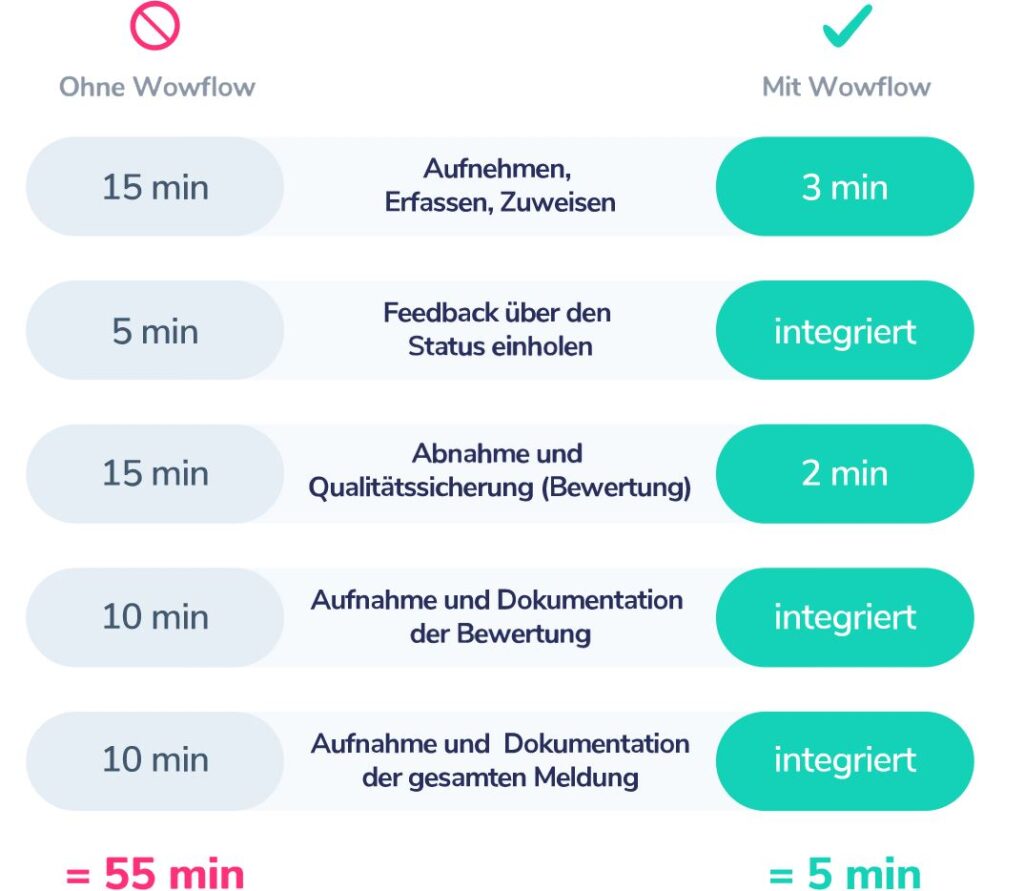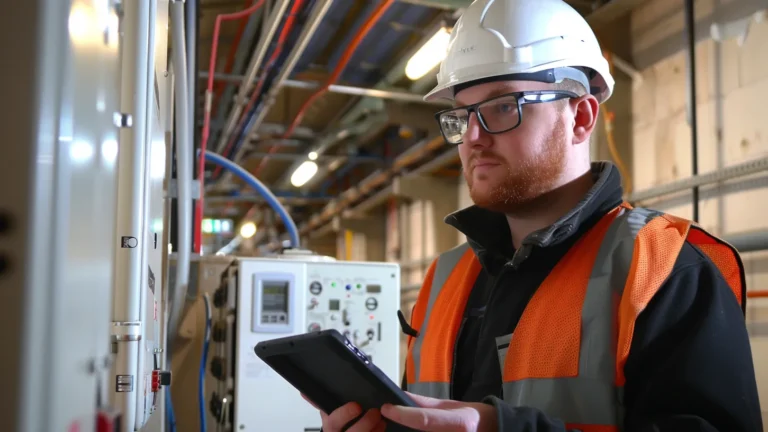Anyone who works in a facility service company knows:
The activities that are carried out directly at customers’ premises are just the tip of the iceberg.
Let’s illustrate this right at the beginning: A cleaner is fully occupied with work, the margins are low – in other words, a lot of work has to be done in a short space of time. The specialist should also document the work they have carried out: Photos before and after, meter readings, reporting irregularities such as clutter or damage. Under time pressure, all this information has to be sent via messenger service. It is therefore no wonder that there is hardly any documentation or that office management takes a long time to summarize it coherently.
In addition, the cleaning staff’s workflow is often not optimized. This means that due to the long journeys, logistics and transportation of tools, it is not possible to clean the optimum number of stairwells, for example. This situation is not unique to cleaning companies – it is common to all facility service and maintenance companies.
This leads us to the following question:
How and where do hidden organizational costs arise in the maintenance of buildings and facility service companies?
To arrive at a meaningful answer, we chose the following approach: As a company that offers a digital solution for maintenance management, we deal with various customers from the industry on a daily basis. Around ten interviews with the decision-makers at these companies brought us closer to answering our question in the first step. Next, we turned to three experts – Dipl.-Ing. Dr. Alexander Redlein, Dipl.-Ing. Dr. Helmut Flögl and Mike Jäger, M.A. – who deal with facility management topics both practically and scientifically . Interestingly – presumably due to the complexity and breadth of the topic – there is no study to date that addresses our exact question. All the more exciting are the results that we were able to achieve through the interviews with experts and decision-makers, as well as the analysis of existing studies on related topics.
At the end of the article, you will probably have a new question: “Why didn’t I deal with this before?”
Administrative activities in facility service and maintenance companies: The status quo
Although the real estate market has seen a number of technological advances in recent years – including IoT sensors, more efficient energy use and blockchain solutions for the sale of apartments – the facility services and maintenance sector has remained relatively stagnant. Not much has changed in this area in the last 15 years. One exception: the emergence of the messenger service WhatsApp as a communication tool in 2013.

The interviews with customers revealed an administrative work process that occurs in technical facility management in this or a similar form. It looks like this:
- The customer calls and reports a concern.
- The receptionist picks up the phone and makes a note of the request.
- Reception checks which service employee is currently available and notifies them.
- The employee receives the order and drives to the customer.
- At best, the order is completed immediately. Employees must keep records of the situation before and after, the work performed and the time spent. (If there are complaints or follow-up orders, the process shown will be extended).
- The customer signs the director’s certificate if it is an individual order.
- The employee returns to the company, hands in the director’s certificate and/or the documentation of the service performed.
- The director’s certificate and invoice will be sent to the customer (by post or e-mail).
- The director’s license is taken.
- In the event of warranty claims or complaints, we will be looking for the director’s certificate together with documentation (e.g. photos).
In most cases, a messenger service such as WhatsApp is used to coordinate orders and employees. The filing of the individually created documents is not automated and takes place in a folder structure. In some cases, however, reports and photos are only stored on the mail server or remain in WhatsApp. Another part of the day-to-day work of building maintenance assistants is scheduling employees using a calendar in Outlook and planning, recording and updating activities in an Excel list.
The surveys also revealed the following shortcomings :
- In some cases, there is little or no professional reporting after completion of an assignment. “Sometimes I have to manually enter up to 160 photos from WhatsApp into a Word document for each job,” reports one Wowflow customer.
- Complete documentation is seldom available, as this represents a high administrative burden. There is a lack of valid documents or evidence when a complaint is made.
- Searching for information such as reports and photos takes (too) much time. Sometimes it even takes several hours – especially when it comes to complaints or warranty processing.
- In some cases, managing a key alone can take up to 20 minutes.
According to Redlein, one of the biggest administrative time wasters is the creation of master data. He explains the topic using the example of an elevator. When it comes to preventive maintenance, a number of points must always be clarified in advance. These include, for example
- Which elevator laws apply in the region in question?
- What does the elevator manufacturer recommend?
- What type is it?
- What requirements apply to this particular elevator? (In hospitals, for example, more specific requirements apply than in an office building).
All this master data – and more – must be created for every conceivable system in the building to be managed.
The processes and problems outlined above are generally known in the industry, but are often overlooked. Why?
They have become ingrained in the company structure over the last ten to 15 years. Managers and employees become “operationally blind” due to the increased flow of information – they don’t even see the problem. This makes it all the more important to be made aware of the problem.
Building maintenance: administrative work of up to 100 hours per week
The fact is: the process shown above in bullet points takes 15 to 60 minutes – depending on whether it is reactive or preventive maintenance and how much documentation is required. The actual work of the service team is excluded. It is purely a matter of communication, coordination and proper documentation.

The actual administrative workload naturally depends on the size of the company – for SMEs in the field of technical facility management, we can be talking about up to 100 hours per week. These 100 hours are made up as follows: 27 service or building services employees spend a total of 67.5 hours a week on admin activities. The administrative staff number around ten – depending on the intensity of the documentation and the work carried out by the technical team. With two project managers, this amounts to around twelve administrative working hours per week – also depending on factors such as the coordination and communication effort. (Note: All these and other figures quoted in this article are based on our surveys of customers).

What does this expense consist of?
In her dissertation “Profitability of Facility Management”, Susanne Hauk lists the FM cost driver of data collection and processing at 44 percent. This means that almost half of the facility managers she surveyed in Austrian companies stated that the processing and recording of data was a cost driver. A statement that was only confirmed by our surveys and the master data problem mentioned by Redlein.
It has also been shown that another large part of administrative activities consists of communication . This refers to communication with:
- Employees of the company
- External service providers, suppliers and partners,
- Customers, owners and tenants
Information is usually exchanged via phone calls, emails or messenger services. The latter is frequently used in internal communication in particular. All these ways of communicating are time wasters, but are rarely seen as such. Because communication is – quite clearly – essential and unavoidable.
One component that also leads to hidden costs in a broader sense is travel times. Another example: A service employee has a job on the other side of town. Experience shows that the procedure is usually as follows:
- Obtaining information from reception staff (by telephone, in writing or in person)
- Collect keys from the office
- Carry out the order – if material or tools are missing, you have to drive back and forth again
- Return keys to the office
- Hand in the director’s certificate at the secretary’s office

Depending on the location of the order, this process can take several hours. As already mentioned, in some cases up to 30 minutes have to be spent on key management alone – which in turn has to be passed on to the client as a lump sum.
What does the administrative effort cost a facility service or maintenance company?
If we convert the processes described above into costs, we are in for some nasty surprises. This is illustrated in the table below. The average hourly wage (gross) of a back office employee is 20 euros. Multiplied by ten hours per week for administrative activities (for SMEs), that’s 200 euros spent per week. According to our calculations, two project managers cost 360 euros per week. With 27 in-house technicians employed at an hourly rate of 22 euros, this amounts to 1,485 euros per week. Mind you:
This total of 106,340 euros per year is not a rechargeable benefit.
Mr. Jäger from MACH Energiegesellschaft can also confirm this: “The customer rarely honors administrative times. The current tenders for facility management and facility services reflect this. The excessive reporting requirements, some of which are not even read, are immense. In fact, they demand facility management and brain power that do not conform to the customer image of FM as a janitor service.”
What’s more, the more administrative work, the more manpower is needed (1.5 administrative staff for every 12-15 employees in the technical area, according to Jäger). Expenditure on the corresponding personnel increases – a vicious circle.
Facility service and maintenance companies have been working for the last ten to 15 years in the way described in this article. So why should this be changed?
The answer is simple: times have changed.
Firstly, it is becoming increasingly difficult to find well-trained facility management personnel(source). And secondly, we are talking about a low-margin business – every cent counts.
In this environment, it makes no sense to spend up to 100 hours a week on administrative tasks that cannot be passed on to the customer.
What facility service and maintenance companies could achieve with the time and cost savings gained
The study “Savings potential, productivity increase and cost drivers in facility management” carried out by Redlein shows that a productivity increase of 26% is possible in the area of building maintenance through the use of synergies between services (16%), process optimization (13%) and organizational optimization (11%). As an example of synergies, Redlein mentions that security staff could not only walk the corridors during the night shift, but also check the emergency lighting. The person then needs to be trained a little better, but there are no costs and no time for carrying out the checks separately.

Without going into the individual options in detail in this article, we would like to briefly outline what you can do with the resources you save:
- Extended sales opportunities
- Improved service quality for existing customers
- Acquisition of new customers
- Increased employee satisfaction
- Time for further training
How are you and your company doing with this topic? Do you struggle with the same or similar challenges? Or have you already found a satisfactory solution for your company, your employees and your customers?
If you would like to discuss this topic with us or feel that we can help you with the problems shown, please do not hesitate to contact us.
We deal with similar topics on an ongoing basis and consult experts from the industry. You can find our other blog articles here:



